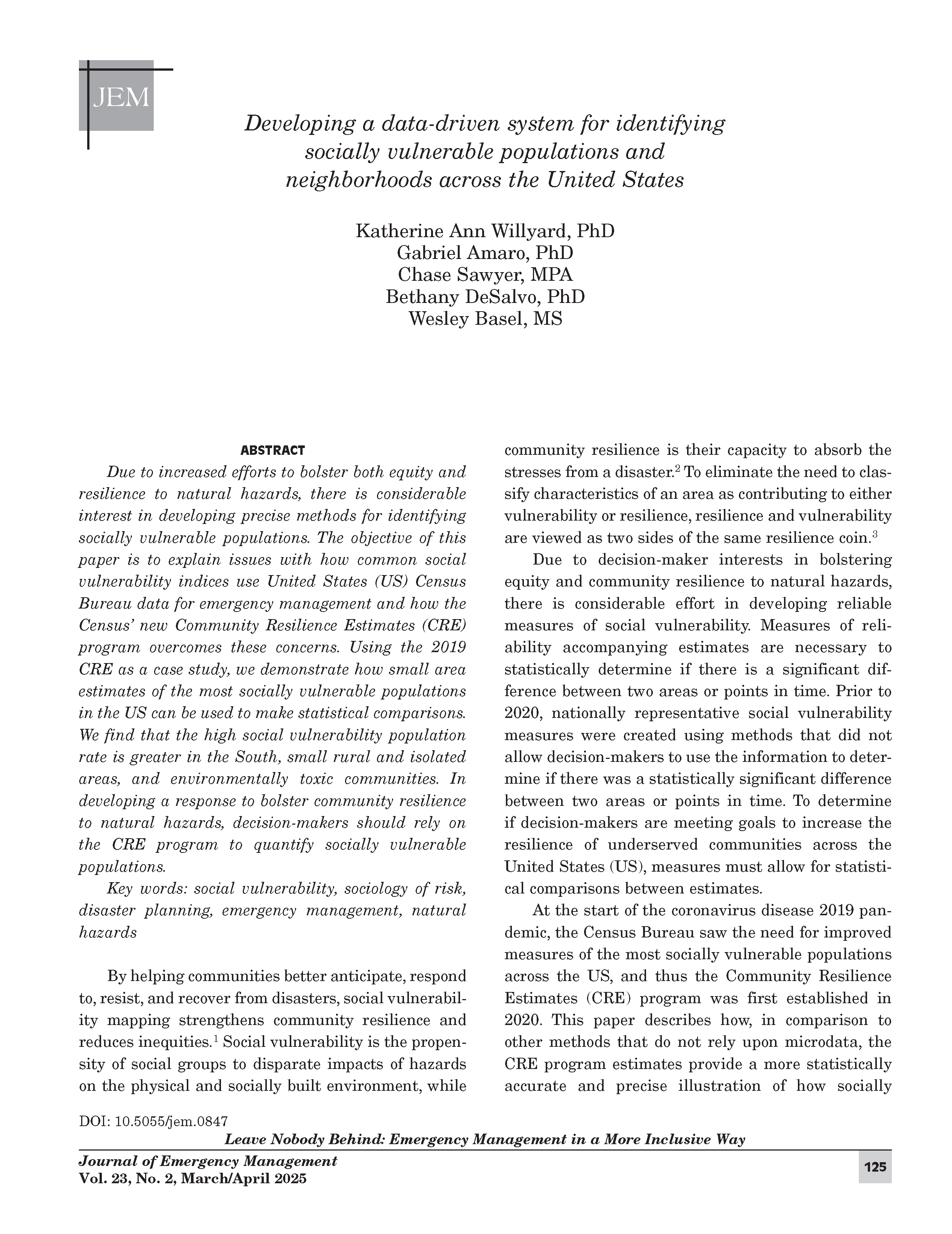Developing a data-driven system for identifying socially vulnerable populations and neighborhoods across the United States
DOI:
https://doi.org/10.5055/jem.0847Keywords:
social vulnerability, sociology of risk, disaster planning, emergency management, natural hazardsAbstract
Due to increased efforts to bolster both equity and resilience to natural hazards, there is considerable interest in developing precise methods for identifying socially vulnerable populations. The objective of this paper is to explain issues with how common social vulnerability indices use United States (US) Census Bureau data for emergency management and how the Census’ new Community Resilience Estimates (CRE) program overcomes these concerns. Using the 2019 CRE as a case study, we demonstrate how small area estimates of the most socially vulnerable populations in the US can be used to make statistical comparisons. We find that the high social vulnerability population rate is greater in the South, small rural and isolated areas, and environmentally toxic communities. In developing a response to bolster community resilience to natural hazards, decision-makers should rely on the CRE program to quantify socially vulnerable populations.
References
Van Zandt S, Peacock WG, Henry DW, et al.: Mapping social vulnerability to enhance housing and neighborhood resilience. Housing Policy Debate. 2012; 22: 29-55.
Masterson JH, Peacock WG, Van Zandt S, et al.: Planning for Community Resilience: A Handbook for Reducing Vulnerability to Disasters. Washington, DC: Island Press, 2014.
Summers JK, Smith L, Harwell LC, et al.: Conceptualizing holistic community resilience to climate events: Foundation for a climate resilience screening index. GeoHealth. 2017; 1: 151-164.
Edgemon L, Freeman C, Burdi C, et al.: Community resilience indicator analysis: County-level analysis of commonly used indicators from peer reviewed research. Available at https://www.researchgate.net/profile/Lesley-Edgemon/publication/331232094_community_resilience_indicator_analysis_County-Level_analysis_of_commonly_used_indicators_from_Peer-Reviewed_research/links/5c6d86fd4585156b570d2c91/Community-Resilience-Indicator-Analysis-County-Level-Analysis-of-Commonly-Used-Indicators-From-Peer-Reviewed-Research.pdf. Accessed October 31, 2023.
US Census Bureau: Statistical quality standards. Available at https://www2.census.gov/about/policies/quality/quality-standards.pdf. Accessed October 31, 2023.
Bowers L, Basel W, Powers D: Evaluating 2012-2014 trends in health insurance coverage for all US counties. Available at https://www.census.gov/library/working-papers/2016/demo/SEHSD-WP2016-16.html. Accessed October 31, 2023.
Raglin D: Period estimates in the American community survey. Available at https://www.census.gov/newsroom/blogs/randomsamplings/2022/03/period-estimates-american-community-survey.html#:~:text=how%20should%20users%20compare%205,any%20overlapping%20years%20of%20data. Accessed October 31, 2023.
US Census Bureau: Understanding error and determining statistical significance. Available at https://www.census.gov/content/dam/census/library/publications/2020/acs/acs_general_handbook_2020_ch07.pdf. Accessed October 31, 2023.
Flanagan B, Hallisey E: The social vulnerability index and tool kit. Available at https://svi.cdc.gov/documents/publications/CDC_ATSDR_SVI_materials/SVI_30April2013.pdf. Accessed October 31, 2023.
Hazards and Vulnerability Research Institute: The SoVI® recipe. Available at https://www.sc.edu/study/colleges_schools/artsandsciences/centers_and_institutes/hvri/documents/sovi/sovi_recipe_2016.pdf. Accessed October 31, 2023.
US Environmental Protection Agency: EJSCREEN technical documentation. Available at https://www.epa.gov/sites/default/files/2021-04/documents/ejscreen_technical_document.pdf. Accessed October 31, 2023.
Wright T, Klein M, Wieczorek J: Ranking populations based on sample survey data. Available at https://www.census.gov/library/working-papers/2014/adrm/rrs2014-12.html. Accessed October 31, 2023.
US Census Bureau: Making comparisons with ACS data. Available at https://www.census.gov/content/dam/census/library/publications/2020/acs/acs_general_handbook_2020_ch04.pdf. Accessed October 31, 2023.
Tate E: Uncertainty analysis for a social vulnerability index. Methods Models GIS. 2012; 103: 526-543.
National Research Council: Small-area income and poverty estimates: Priorities for 2000 and beyond. Available at https://nap.nationalacademies.org/login.php?record_id=9957. Accessed October 31, 2023.
National Center for Science and Engineering Statistics: National patterns of R&D resources: Future directions for content and methods. Available at https://nap.nationalacademies.org/login.php?record_id=18317. Accessed October 31, 2023.
US Census Bureau: Small area income and poverty estimates (SAIPE) program. Available at https://www.census.gov/programssurveys/saipe.html. Accessed October 31, 2023.
US Census Bureau: Small area health insurance estimates (SAHIE) program. Available at https://www.census.gov/programssurveys/sahie.html. Accessed October 31, 2023.
Rao JNK, Molina I: Small Area Estimation. 2nd ed. Hoboken, NJ: Wiley, 2015.
Bell W, Basel W, Cruse C, et al.: Use of ACS data to produce SAIPE model-based estimates of poverty for counties. Available at https://www.census.gov/library/working-papers/2007/demo/bell-01.html. Accessed October 31, 2023.
Sawyer RC, DeSalvo B: New census bureau tool will now consistently update communities on their vulnerable populations. Available at https://www.census.gov/library/stories/2021/09/measuring-communities-resilience-in-the-face-of-adversity.html. Accessed October 31, 2023.
US Census Bureau: Community resilience estimates. Available at https://www.census.gov/programs-surveys/community-resilienceestimates.html. Accessed October 31, 2023.
Sawyer RC, DeSalvo B, Allen T: Community resilience estimates tool examines at-risk factors from low income to lack of health insurance. Available at https://www.census.gov/library/stories/2022/03/census-data-tool-helps-fema-better-understanddisaster-vulnerability.html. Accessed October 31, 2023.

Published
How to Cite
Issue
Section
License
Copyright 2007-2025, Weston Medical Publishing, LLC and Journal of Emergency Management. All Rights Reserved.





